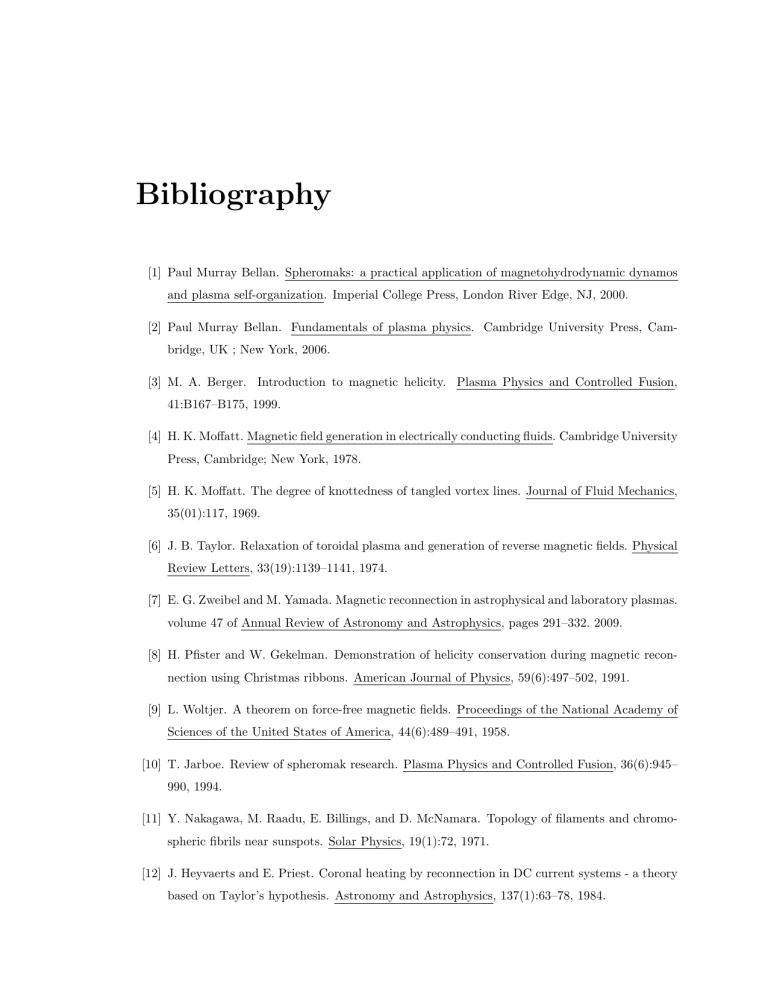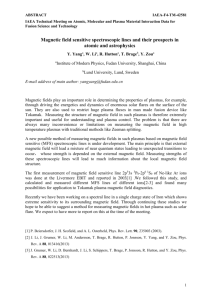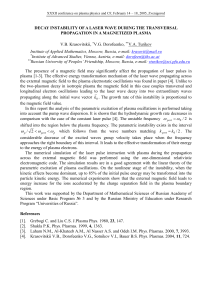PDF (Bibliography)

Bibliography
[1] Paul Murray Bellan. Spheromaks: a practical application of magnetohydrodynamic dynamos and plasma self-organization. Imperial College Press, London River Edge, NJ, 2000.
[2] Paul Murray Bellan. Fundamentals of plasma physics. Cambridge University Press, Cambridge, UK ; New York, 2006.
[3] M. A. Berger. Introduction to magnetic helicity. Plasma Physics and Controlled Fusion,
41:B167–B175, 1999.
[4] H. K. Moffatt. Magnetic field generation in electrically conducting fluids. Cambridge University
Press, Cambridge; New York, 1978.
[5] H. K. Moffatt. The degree of knottedness of tangled vortex lines. Journal of Fluid Mechanics,
35(01):117, 1969.
[6] J. B. Taylor. Relaxation of toroidal plasma and generation of reverse magnetic fields. Physical
Review Letters, 33(19):1139–1141, 1974.
[7] E. G. Zweibel and M. Yamada. Magnetic reconnection in astrophysical and laboratory plasmas.
volume 47 of Annual Review of Astronomy and Astrophysics, pages 291–332. 2009.
[8] H. Pfister and W. Gekelman. Demonstration of helicity conservation during magnetic reconnection using Christmas ribbons. American Journal of Physics, 59(6):497–502, 1991.
[9] L. Woltjer. A theorem on force-free magnetic fields. Proceedings of the National Academy of
Sciences of the United States of America, 44(6):489–491, 1958.
[10] T. Jarboe. Review of spheromak research. Plasma Physics and Controlled Fusion, 36(6):945–
990, 1994.
[11] Y. Nakagawa, M. Raadu, E. Billings, and D. McNamara. Topology of filaments and chromospheric fibrils near sunspots. Solar Physics, 19(1):72, 1971.
[12] J. Heyvaerts and E. Priest. Coronal heating by reconnection in DC current systems - a theory based on Taylor’s hypothesis. Astronomy and Astrophysics, 137(1):63–78, 1984.
198
[13] A. Choudhuri and A. Konigl. Magnetic energy dissipation in force-free jets. Astrophysical
Journal Letters, 310(1):96–103, 1986.
[14] J. M. Finn, P. N. Guzdar, and D. Usikov. Three-dimensional force-free looplike magnetohydrodynamic equilibria. Astrophysical Journal, 427(1):475–482, 1994. Part 1.
[15] D. M. Rust and A. Kumar. Helical magnetic fields in filaments. Solar Physics, 155(1):69–97,
1994.
[16] T. H. Jensen. Current drive and helicity injection. The Physics of Fluids, 27(12):2881, 1984.
formation. Physical Review Letters, 103(10), 2009.
[18] P. M. Bellan and J. F. Hansen. Laboratory simulations of solar prominence eruptions. Physics of Plasmas, 5(5):1991–2000, 1998.
[19] J. F. Hansen and P. M. Bellan. Experimental demonstration of how strapping fields can inhibit solar prominence eruptions. Astrophysical Journal, 563(2):L183–L186, 2001.
[20] J. F. Hansen, S. K. P. Tripathi, and P. M. Bellan. Co- and counter-helicity interaction between two adjacent laboratory prominences. Physics of Plasmas, 11(6):3177–3185, 2004.
[21] John Freddy Hansen. Laboratory Simulations of Solar Prominences. PhD thesis, California
Institute of Techonology, Pasadena, CA, May 2001.
[22] S.W. Kahler, R.L. Moore, S.R. Kane, and H. Zirin. Filament eruptions and the impulsive phase of solar flares. Astrophysical Journal, 328:824–829, 1988.
[23] Y. Ono, M. Yamada, T. Akao, T. Tajima, and R. Matsumoto. Ion acceleration and direct ion heating in three-component magnetic reconnection. Physical Review Letters, 76(18):3328–
3331, 1996.
[24] M. Yamada, Y. Ono, A. Hayakawa, M. Katsurai, and F. W. Perkins. Magnetic reconnection of plasma toroids with cohelicity and counterhelicity. Physical Review Letters, 65(6):721–724,
1990.
[25] C. D. Cothran. Observation of a helical self-organized state in a compact toroidal plasma.
Physical Review Letters, 103(21):215002, 2009.
[26] T. Gray.
Three-dimensional reconnection and relaxation of merging spheromak plasmas.
Physics of Plasmas, 17(10):102106, 2010.
PhD thesis, University of Maryland, 1993.
199
[28] J. F. Drake, M. A. Shay, W. Thongthai, and M. Swisdak. Production of energetic electrons during magnetic reconnection. Physical Review Letters, 94(9):095001, 2005.
[29] J. F. Drake, M. Swisdak, H. Che, and M. A. Shay. Electron acceleration from contracting magnetic islands during reconnection. Nature, 443(7111):553–556, 2006.
[30] S. von Goeler, W. Stodiek, and N. Sauthoff. Studies of internal disruptions and m = 1 oscillations in tokamak discharges with soft-x-ray techniques. Physical Review Letters, 33(20):1201–
1203, 1974.
[31] P. V. Savrukhin. Generation of suprathermal electrons during magnetic reconnection at the sawtooth crash and disruption instability in the T-10 tokamak. Physical Review Letters,
86(14):3036, 2001.
[32] P.V. Savrukhin and S.V. Tsaun. Sawtooth instability and magnetic reconnection in tokamak plasma. In 19th IAEA Fusion Energy Conference. IAEA, 2002.
en and Carl-Gunne F¨ Cosmical electrodynamics; fundamental principles. Clarendon Press, Oxford, 1963.
[34] L. D. Landau and E. M. Lifshitz. Mechanics. Course of theoretical physics. Pergamon Press,
Oxford; New York, 3rd edition, 1976.
[35] T. G. Northrop and E. Teller. Stability of the adiabatic motion of charged particles in the
Earth’s field. Physical Review, 117(1):215–225, 1960.
[36] Gunsu Soonshin Yun.
Dynamics of plasma structures interacting with external and self-generated magnetic fields. PhD thesis, California Institute of Techonology, Pasadena,
CA, July 2007.
[37] D. Kumar, A. Moser, and P. Bellan. Energy efficiency analysis of the discharge circuit of
Caltech Spheromak Experiment. IEEE Transactions on Plasma Science, 38(1):47–52, 2010.
[38] M. D. Kruskal. Hydromagnetic instability in a stellarator. The Physics of Fluids, 1(5):421,
1958.
[39] V.D. Shafranov. On magnetohydrodynamical equilibrium configurations. Soviet Physics JETP,
6:545–54, 1958.
[40] P. M. Bellan. Why current-carrying magnetic flux tubes gobble up plasma and become thin as a result. Physics of Plasmas, 10(5):1999–2008, 2003. 44th Annual Meeting of the Division of Plasma of the American Physical Society.
200
[41] G. Yun and P. Bellan. Plasma tubes becoming collimated as a result of magnetohydrodynamic pumping. Physics of Plasmas, 17(6):062108, 2010.
[42] S. K. P. Tripathi, P. M. Bellan, and G. S. Yun. Observation of kinetic plasma jets in a coronal-loop simulation experiment. Physical Review Letters, 98(13), 2007.
[43] E. V. Stenson. Dual-species plasmas illustrate MHD flows. IEEE Transactions on Plasma
Science, 36(4):1206, 2008.
[44] The Center for X-Ray Optics. X-ray interactions with matter. URL http://henke.lbl.gov/ optical_constants .
[45] G. S. Yun, S. You, and P. M. Bellan. Large density amplification measured on jets ejected from a magnetized plasma gun. Nuclear Fusion, 47(3):181–188, 2007.
[46] S. You, G. S. Yun, and P. M. Bellan. Dynamic and stagnating plasma flow leading to magnetic flux tube collimation. Physical Review Letters, 95(4), 2005.
[47] V. H. Chaplin, M. R. Brown, D. H. Cohen, T. Gray, and C. D. Cothran. Spectroscopic measurements of temperature and plasma impurity concentration during magnetic reconnection at the Swarthmore Spheromak Experiment. Physics of Plasmas, 16(4), 2009.
[48] S. J. Zweben, C. R. Menyuk, and R. J. Taylor. Vacuum photodiode detector array for broadband UV detection in a tokamak plasma. Review of Scientific Instruments, 50(8):972–978,
1979.
[49] P. Lee, J. Gernhardt, C. J. Armentrout, and R. T. Snider. Vacuum ultraviolet and ultrasoft x-ray diode detectors for tokamak plasmas. Review of Scientific Instruments, 59(6):883–888,
1988.
[50] S. J. Zweben and R. J. Taylor. Filtered and bare vacuum photodiode detectors for VUV monitoring of tokamak plasmas. Plasma Physics and Controlled Fusion, 23(4):337–346, 1981.
[51] H. N. Kornblum and V. W. Slivinsky. Flat-response, subkiloelectronvolt x-ray detector with a subnanosecond time response. Review of Scientific Instruments, 49(8):1204–1205, 1978.
[52] F. P. Adams, A. Ng, and Y. Gazit. Simple, high-speed x-ray diode. Review of Scientific
Instruments, 58(6):1130–1132, 1987.
[53] J. R. Kerns and D. J. Johnson. Study of an electron-beam discharge into a vacuum diode with polyethylene anode. Journal of Applied Physics, 45(12):5225–5228, 1974.
[54] G. Idzorek and H. Oona. Properties of plasma radiation diagnostics. Review of Scientific
Instruments, 68(1):1065–1068, 1997.
201
[55] F. H. Seguin, R. D. Petrasso, and C. K. Li. Radiation-hardened x-ray imaging for burningplasma tokamaks. Review of Scientific Instruments, 68(1):753–756, 1997. 11th Topical Conference on High-Temperature Plasma Diagnostics.
[56] Y. V. Gott and M. M. Stepanenko. Vacuum photodiode detectors for soft x-ray ITER plasma tomography. Review of Scientific Instruments, 76(7), 2005.
[57] Space environment (natural and artificial) - Process for determining solar irradiances. Technical
Report ISO 21348, International Organization for Standardization, 2007.
Review of Scientific Instruments, 36(1):19–21, January 1965.
[59] R.B. Cairns and J.A.R. Samson. Metal photocathodes as secondary standards for absolute intensity measurements in the vacuum ultraviolet. Journal of the Optical Society of America,
56(11):1586, 1573 1966.
[60] PerkinElmer. Short Arc Xenon Flashlamp.
[61] Janis Research.
Window transmision curves.
URL http://www.janis.com/products/ accessoriesandancillaryequipment/WindowTransmissionCurves.aspx
.
[62] C. Kenty. Photoelectric yields in the extreme ultraviolet. Physical Review, 44:891–897, 1933.
[63] N. Wainfan, W.C. Walker, and G.L. Weissler. Preliminary results on photoelectric yields of
Pt and Ta and on photoionization in O
2 and N
2 in the vacuum ultraviolet. Journal of Applied
Physics, 24(10):1318–1321, October 1953.
[64] W.C. Walker, N. Wainfan, and G.L. Weissler. Photoelectric yields in the vacuum ultraviolet.
Journal of Applied Physics, 26(11):1366–1371, November 1955.
[65] H.E. Hinteregger and K. Watanabe. Photoelectric cells for the vacuum ultraviolet. Journal of the Optical Society of America, 43(7):604–608, July 1953.
[66] H.E. Hinteregger.
Photoelectric emission in the extreme ultraviolet.
Physical Review,
96(2):538–539, 1954.
[67] R. Brogle, P. Muggli, P. Davis, G. Hairapetian, and C. Joshi. Studies of linear and nonlinear photoelectric emission for advanced accelerator applications. Proceedings of the 1995 Particle
Accelerator Conference, Vols 1-5, pages 1039–1042, 1996.
[68] Stuart M. Wentworth. Applied electromagnetics: early transmission lines approach. Wiley series in electrical and computer engineering. John Wiley, Hoboken, NJ, 2007.
202
[69] I. Langmuir. The effect of space charge and residual gases on thermionic currents in high vacuum. Physical Review, 2(6):450–486, 1913.
[70] E. Vance.
Shielding effectiveness of braided-wire shields.
Electromagnetic Compatibility, EM17(2):71–77, 1975.
IEEE Transactions on
[71] Y. H. Lin and D. C. Joy. A new examination of secondary electron yield data. Surface and
Interface Analysis, 37(11):895–900, 2005.
[72] F. M. Propst and E. Luscher. Auger electron ejection from tungsten surfaces by low-energy ions. Physical Review, 132(3):1037, 1963.
[73] I. A. Abroyan, M. A. Eremeev, and N. N. Petrov. Excitation of electrons in solids by relatively slow atomic particles. Soviet Physics Uspekhi, 10(3):332–367, 1967.
[74] V. Baglin, J. Bojko, O. Grobner, B. Henrist, N. Hillret, C. Scheuerlein, and M. Taborelli.
The secondary electron yield of technical materials and its variation with surface treatment.
Proceedings of EPAC 2000, pages 217 – 221, 2000.
[75] J. D. Huba. NRL plasma formulary. Naval Research Laboratory, 2009.
[76] ThorLabs. 150 nm to 4.6
µ m amplified photodetectors. URL http://www.thorlabs.us/ thorProduct.cfm?partNumber=PDA36A .
[77] Takashi Fujimoto. Plasma Spectroscopy. Clarendon Press ; Oxford University Press, Oxford;
New York, 2004.
[78] S. Costa, R. Deangelis, S. Ortolani, and M. Puiatti. Total radiation measurements in the
ETA-BETA II experiment. Nuclear Fusion, 22(10):1301–1311, 1982.
[79] George B. Rybicki and Alan P. Lightman. Radiative processes in astrophysics. Wiley-VCH,
New York, 2004.
[80] Yu. Ralchenko, A.E. Kramida, J. Reader, and NIST ASD Team.
NIST Atomic Spectra
Database (ver. 4.0.1). National Institute of Standards and Technology, Gaithersburg, MD,
2010. URL http://physics.nist.gov/asd .
[81] J. L. Terry, B. Lipschultz, A. Yu. Pigarov, S. I. Krasheninnikov, B. LaBombard, D. Lumma,
H. Ohkawa, D. Pappas, and M. Umansky. Volume recombination and opacity in Alcator
C-Mod divertor plasmas. Physics of Plasmas, 5(5):1759–1766, 1998.
[82] R. W. P. McWhirter and A. G. Hearn. A calculation of instantaneous population densities of excited levels of hydrogen-like ions in a plasma. Proceedings of the Physical Society of London,
82(529):641–654, 1963.
203
[83] D. E. Post. A review of recent developments in atomic processes for divertors and edge plasmas.
Journal of Nuclear Materials, 220-222:143–157, 1995.
[84] Peter C. Stangeby. The plasma boundary of magnetic fusion devices. Institute of Physics
Pub., Bristol; Philadelphia, 2000.
[85] P. G. Carolan and V. A. Piotrowicz. The behavior of impurities out of coronal equilibrium.
Plasma Physics and Controlled Fusion, 25(10):1065–1086, 1983.
[86] D. G. Whyte, R. P. Seraydarian, and R. P. Doerner. Carbon impurity characterization on a linear plasma device using visible emission spectroscopy. Journal of Vacuum Science and
Technology A: Vacuum, Surfaces, and Films, 17(5):2713–2718, 1999.
[87] P. M. Bellan. Thermal instability of electrolytic capacitor bank used for gas puff valve. Review of Scientific Instruments, 73(8):2900–2905, 2002.
[88] M. Øieroset, R.P. Lin, T.D. Phan, D.E. Larson, and S.D. Bale. Evidence for electron acceleration up to ∼ 300 keV in the magnetic reconnection diffusion region of earth’s magnetotail.
Physical Review Letters, 89(19):195001, 2002.
[89] L. J. Chen. Observation of energetic electrons within magnetic islands. Nature Physics, 4(1):19,
2008.
[90] D. Lumma, J.L. Terry, and B. Lipschultz. Radiative and three-body recombination in the
Alcator C-Mod divertor. Physics of Plasmas, 4(7):2555, 1997.
[91] R. J. Perkins and P. M. Bellan. Wheels within wheels: Hamiltonian dynamics as a hierarchy of action variables. Physical Review Letters, 105(12), 2010.
[92] Herbert Goldstein, Charles P. Poole, and John L. Safko. Classical mechanics. Addison Wesley,
San Francisco, 3rd edition, 2002.
[93] Francis F. Chen. Introduction to plasma physics. Plenum Press, New York, 1974.
[94] V. I. Arnol’d. Mathematical methods of classical mechanics. Graduate texts in mathematics
60. Springer, New York, 2nd edition, 1997.
[95] Jerrold E. Marsden and Tudor S. Ratiu. Introduction to mechanics and symmetry: a basic exposition of classical mechanical systems. Texts in applied mathematics 17. Springer, New
York, 2nd edition, 1999.
[96] Allan J. Lichtenberg and M. A. Lieberman. Regular and chaotic dynamics. Springer-Verlag,
New York, 1992.
204
[97] Max Born. The mechanics of the atom. F. Ungar Pub. Co., New York,, 1960.
[98] D. J. Griffiths. Introduction to electrodynamics. Prentice Hall International, London, 1999.
[99] K. Stefanski and H. S. Taylor. New approach to understanding quasiperiodicity in nonintegrable Hamiltonian systems. Physical Review A, 31(5):2810–2820, 1985.
[100] D. L. Bruhwiler and J. R. Cary. Particle dynamics in a large-amplitude wave packet. Physical
Review Letters, 68(3):255–258, 1992.
[101] M.C. Gutzwiller. Energy spectrum according to classical mechanics. Journal of Mathematical
Physics, 11(6):1791–1806, 1970.
[102] Y. Aharonov. Significance of electromagnetic potentials in the quantum theory. Physical
Review, 115(3):485, 1959.
[103] R. Montgomery. How much does the rigid body rotate? A Berry’s phase from the 18th century.
American Journal of Physics, 59(5):394–398, 1991.
[104] Dariusz Chruscinski and Andrzej Jamiolkowski. Geometric phases in classical and quantum
[105] J. D. Lawson. Simple models of solid and hollow relativistic electron beams with arbitrarily high current. Physics of Fluids, 16(8):1298–1299, 1973.
[106] J. Neuberger and J. Gruenebaum. Trajectories of charged particles near a long straight wire.
European Journal of Physics, 3, 1982.
[107] Milton Abramowitz and Irene A. Stegun. Handbook of mathematical functions with formulas, graphs, and mathematical tables. U.S. Government Printing Office, Washington D.C., 1964.
[108] M. J. Wouters. Ion optical properties of a co-axial Wien filter. Journal of Physics D-Applied
Physics, 28(8):1547–1552, 1995.
0429, 1939.
[110] J. G. Chervenak. The back electric-field from a long wire. American Journal of Physics,
54(10):946–947, 1986.
[111] M. A. Heald. Induced electric field from a time-dependent current. American Journal of
Physics, 54(12):1142–1143, 1986.
[112] M. A. Heald. Electric fields and charges in elementary circuits. American Journal of Physics,
52(6):522–526, 1984.
205
[113] T. W. Speiser. Particle trajectories in model current sheets, 2. Applications to auroras using a geomagnetic tail model. Journal of Geophysical Research, 72(15):3919, 1967.
[114] C. Hewson. The effect of electrostatic screening of Rogowski coils designed for wide-bandwidth current measurement in power electronic applications. IEEE Power Electronics Specialists
Conference (PESC), 2:1143, 2004.
[115] C. Størmer. The Polar Aurora. Oxford at the Claredon Press, London, 1955.
[116] J. V. Shebalin. Størmer regions for axisymmetric magnetic multipole fields. Physics of Plasmas,
11(7):3472–3482, 2004.
Space Weather, 5(4), 2007.
[118] T. W. Kornack, P. K. Sollins, and M. R. Brown. Experimental observation of correlated
[119] R. G. Littlejohn. The semiclassical evolution of wave packets. Physics Reports, 138(4-5):193,
1986.
[120] I. Y. Dodin and N. J. Fisch. Nonadiabatic ponderomotive potentials. Physics Letters A,
349(5):356–369, 2006.






